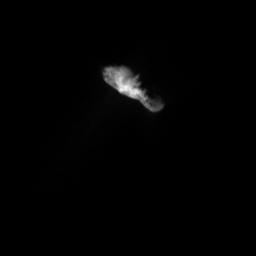
|
Comet Borrelly’s Varied Landscape
- Click the image above for a larger view
- Full-Res JPEG (500 x 500) (4.7 kB)
- Full-Res TIFF (500 x 500) (34.9 kB)
Caption:
In this Deep Space 1 image of comet Borrelly, sunlight illuminates the bowling-pin shaped nucleus from directly below. At this distance, many features become vivid on the surface of the nucleus, including a jagged line between day and night on the comet, rugged terrain on both ends with dark patches, and smooth, brighter terrain near the center. The smallest discernible features are about 110 meters (120 yards) across.
Background Info:
Deep Space 1 completed its primary mission testing ion propulsion and 11 other advanced, high-risk technologies in September 1999. NASA extended the mission, taking advantage of the ion propulsion and other systems to undertake this chancy but exciting, and ultimately successful, encounter with the comet. More information can be found on the Deep Space 1 home page at http://nmp.jpl.nasa.gov/ds1/ .
Deep Space 1 was launched in October 1998 as part of NASA's New Millennium Program, which is managed by JPL for NASA's Office of Space Science, Washington, D.C. The California Institute of Technology manages JPL for NASA.
Cataloging Keywords:
| Name | Value | Additional Values |
|---|---|---|
| Target | 19P/Borrelly | |
| System | Periodic Comets | |
| Target Type | Comet | |
| Mission | Deep Space 1 (DS1) | |
| Instrument Host | Deep Space 1 | |
| Host Type | Flyby Spacecraft | |
| Instrument | Miniature Integrated Camera Spectrometer (MICAS) | |
| Detector | ||
| Extra Keywords | Grayscale | |
| Acquisition Date | ||
| Release Date | 2001-11-03 | |
| Date in Caption | ||
| Image Credit | NASA/JPL | |
| Source | photojournal.jpl.nasa.gov/catalog/PIA03504 | |
| Identifier | PIA03504 | |
